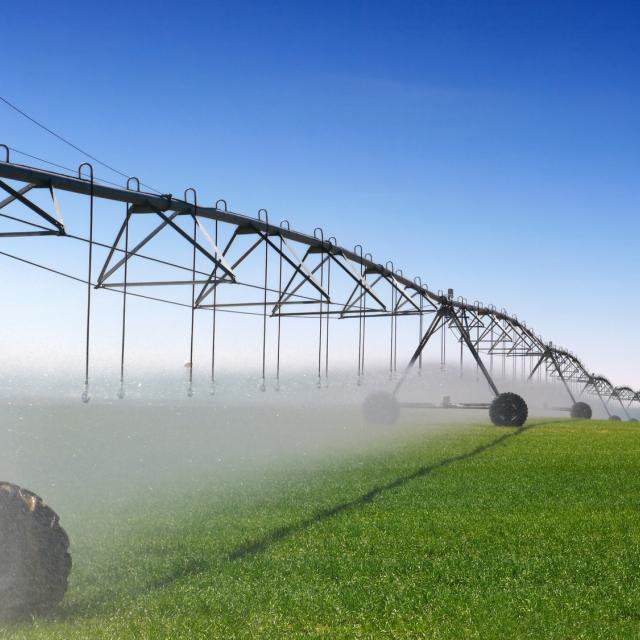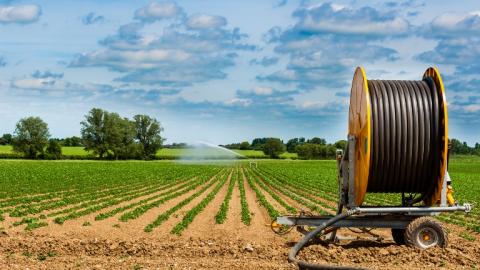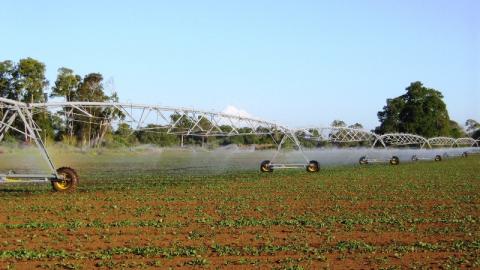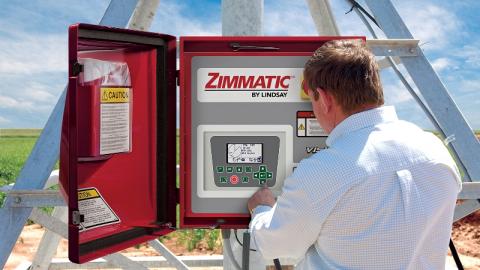1. What are Centre Pivot and Lateral Move Systems?
Centre Pivot and Lateral Move systems are self-propelled irrigation systems, which apply water to pasture or crop, generally from above the canopy.
Centre Pivot systems are anchored at one end and rotate around a fixed central point. Lateral systems are not anchored and both ends of the machine move at a constant speed up and down a paddock.
Centre Pivot and Lateral Move systems require an energy source to move water from the source to the plant as well as energy to move the machine on farm.

1. What are Centre Pivot and Lateral Move Systems?
Centre Pivot and Lateral Move systems are self-propelled irrigation systems, which apply water to pasture or crop, generally from above the canopy.
Centre Pivot systems are anchored at one end and rotate around a fixed central point. Lateral systems are not anchored and both ends of the machine move at a constant speed up and down a paddock.
Centre Pivot and Lateral Move systems require an energy source to move water from the source to the plant as well as energy to move the machine on farm.
2. What are the key components of Centre Pivot or Lateral Move systems?
Centre Pivot or Lateral Move systems consist of the following components:
- A span is the pipe and framework between two towers
- A tower supports the spans and contains drive mechanisms and wheels
- Outlets are the points at which water exits the main pipes
- Emitters are attached at outlets either directly or on rigid or flexible droppers. Water isapplied to the plants throughemitters
- Droppers are rigid or flexible small diameter pipes that allow emitters to be placed closer to the ground
Lateral Move systems share similar technology to pivots and are suited to large rectangular areas - up to 200 ha.
3. What are the advantages and disadvantages of Centre Pivot and Lateral Move Systems?
The advantages are:
Precise application:
The systems are able to apply a prescribed volume of water to match crop water requirements. It reduces the opportunity for surface runoff or deep percolation if the system is designed to match soil infiltration characteristics.
Reduced variability:
The reported application efficiencies for new well designed machines are generally in the 80-95% range, compared to 50-90% for surface irrigation systems.
Lower labour requirements:
Labour requirements are generally lower than surface irrigation but depends on the system and\ or the degree of automation of the machine.
Opportunities for fertigation:
Fertigation allows the targeted application of small quantities of nutrients, with a reasonable uniformity of application and less risk of nutrient losses. The irrigation system may also be used to apply herbicides and pesticides.
Less landforming:
The system can work on rolling topography. However, there might be a need for some landforming for surface drainage or rainfall induced runoff.
The disadvantages are:
Cost:
The systems have a relatively high capital cost compared to surface irrigation systems, unless substantial landforming is required for optimum performance of the surface system. The running costs can also be significant and need to be evaluated during the design process.
Energy requirements:
These systems require some form of energy source (electric or diesel) to operate.
Water quality:
Water may need to be filtered before use to prevent system blockages with sediments. Poor water quality can affect longevity of irrigation infrastructure.
Skill requirement:
Operation and maintenance of these systems will require different skills to those required for surface irrigation systems.
4. What do I want to achieve by investing in Centre Pivot and Lateral Move systems?
Before you can make decisions on investing in Centre Pivot or Lateral Move systems, you need to know what you want to achieve by this investment. To make good decisions, you need to have clear objectives and goals. The goals can be related to economic, environmental or social considerations or a combination of these factors. Your goals can depend on many things including your family circumstances, age, financial situation and the duration for which you plan to be in the farm business. You can talk with private farm consultants or attend seminars, workshops or training courses that cover issues that can help you to better define your long-term goals, so you can work towards achieving what you want.
Some of the aspects you may consider are:
- Are you converting to Centre Pivot or Lateral Move systems from border-check system or from a green field site. This could have different implications with regards to costs and what you want to achieve by your investment.
- Is water saving your main goal for considering Centre Pivot or a Lateral Move system? In sandy soil you generally have substantial water savings, but not on heavy soil.
- Is labour saving your main goal?
- There are substantial running costs associated with Centre Pivot and Lateral Move systems. You need to beaware of this.
- The management of Centre Pivot and Lateral Move systems are different from border-check irrigation. Are youready for it?
5. What planning consideration do I need to make?
The following aspects need to be considered at the planning stage:
- Physical location (area, shape, topography, soil type)
- Water supply (flow rate, supply location, quality and quantity)
- Irrigable area (area to be developed, system capacity)
Land area: A typical centre pivot system in the Shepparton Irrigation Region (SIR) has a span of 300 to 400 meters long and irrigates 28 to 50 ha. However, they can be as short as a single-span 35 meter unit or as long as 800 meters with 18 to 20 towers irrigating approximately 200 ha. However, the large systems have high average application rates at the outside of the circle that may exceed the infiltration rate of the soil and consequently cause run-off.
Land shape: Centre Pivot systems irrigate a circle, which covers 78% of a square. This can be an issue on dairy farms with limited available land. End guns used on Centre Pivots to irrigate square properties are not recommended (see below). Lateral Move systems can be an option to irrigate rectangular areas.
Land slope: Centre Pivots can irrigate significantly undulating land. Some minor earthmoving may be needed to connect depression areas and provide drainage for run-off from rainfall events. In some cases, where the development of border check irrigation would require significant cut and fill, the cost per hectare of installing a centre pivot can be lower than border-check irrigation.
Soil type: Centre Pivots are able to irrigate any soil type. However, sprinklers should be selected to suit soil infiltration characteristics, as excessive average application rates can cause runoff. It is desirable the pivot irrigates one soil type or soil types with similar infiltration characteristics.
Planning permit: A planning permit is not required to install the machine; however, a permit is necessary to move soil and native vegetation.
Water supply: The water supply flow rate and the timing and duration of delivery for Centre Pivot and Lateral Move systems can be quite different to those required for border-check irrigation. These systems often require more frequent, but lower flow rates over a longer period of time. For example, where a block of pasture might be irrigated once a week over a 48 hour period under border-check irrigation, a similar block may be irrigated twice a week over 96 hours with Centre Pivot and Lateral Move systems.
It is essential to understand the available water supply rate BEFORE designing the irrigation system. Ask a question - WILL WATER BE AVAILABLE AS REQUIRED - flow rate, duration, frequency? eg., 2 times a week for 2 days at a time.
It is important to note the distance from the water source to the Centre Pivot may impact on capital and running costs.
Water quality: The physical, chemical and biological characteristics of irrigation water can affect pivot performance. Filtration may be required to prevent nozzle blockage.
6. What needs to be considered in the design stage?
'System Capacity' is the most important design criterion for Centre Pivot and Lateral Move systems. In the past many systems were under-designed to minimise costs and were not able to match peak crop water requirements. This resulted in poor crop performance or in severe cases, crop death. This has been the single main reason for Centre Pivot failure.
The system capacity of a Centre Pivot is the rate at which water can be supplied to the irrigated area, expressed in millimetres per day (mm/d). This is typically between 8 and 20 mm/d. It is the main criterion the pump, pipes and sprinkler design is based on, and for a given pivot can be calculated as follows:
For example, with a pump flow rate of 6 ML/day irrigating 50 ha, system capacity is 12 mm/d.
If the system capacity is too low, the system may not be able to supply enough water over a hot spell. A conservative system capacity ensures irrigation requirements can be met comfortably, even under extreme climatic conditions. However, this will increase the investment costs (larger pipes, pumps and / or pressure).
The desired system capacity depends on the water requirement of your crop, the application efficiency of the irrigation system and the operating hours of the system (see Information Note - Centre Pivot System Capacity for more details about determining the desired system capacity).
7. What is the trade-off between capital and operating cost?
The selection of pipe sizes for the span-pipe and mainlines involves a compromise between the capital cost and the operating pressure, the latter of which determines the ongoing operating costs.
For example, a 60 psi machine requires 46 litres of diesel to pump 1 ML of water, whereas, a 25 psi machine with larger but more expensive pipes requires only 27 litres of diesel to pump 1 ML of water. Fifty hectares of pasture under the 60 psi machine is likely to require an additional 9000 litres of diesel. This is an extra $ 9,000 in operating costs per year that could have been avoided by investing extra dollars in up-front capital costs (See Information Note - Centre Pivots - Capital and Operating Cost Trade-off for more details on the trade-off between capital and operating costs).
So the question to ask is:How low can you get the centre pressure for my centre pivot design?
7a. What do I choose - diesel or electric operation?
Electric power is generally preferable for convenience, ease of operation and lower operating costs, if off-peak power can be utilised.
The main consideration in system power supply selection is the cost of providing electricity to the pump site.
7b. What sprinklers do I need?
Moving plate (LEFT) Fixed plate (RIGHT)
There are a wide array of sprinklers and nozzles available. Sprinklers represent less than 7% of the total cost but are responsible for more than 70% of the irrigation performance. There are many varieties of sprinklers and nozzles available.
Fixed plate sprinklers are the simplest and cheapest. They have a relatively small throw and are suitable for pastures provided the sprinkler spacing along the span-pipe is close enough and the average application rate is not excessive.
Moving plate sprinklers have greater throws and produce a more uniform droplet size and a better distribution uniformity.
Talk with your suppliers to get the best outcomes for your requirements. Don't skimp on sprinkler packages during design and purchase.
Replacement of older, poorly performing sprinkler packages can provide a simple and cost effective performance improvement.
7c. Do you really need end-guns for your centre pivot system?
Towable Centre Pivot system
End-guns are generally not recommended because the wetting pattern created by end-guns is generally uneven, particularly under windy conditions (even light winds). End-guns also require more pressure than is required for most modern low-pressure pivot sprinklers, and therefore significantly add to running costs. For example, an end-gun may need 45 psi (30 m head) where 20 psi (14m head) or less is needed for the sprinklers.
If an end-gun is included, it should ideally be pressurised by a booster pump at the end of the pivot.
7d. Is a towable pivot an option?
Most manufacturers offer towable pivot versions. This makes it possible to use one pivot structure to irrigate two or more circles. However, over summer high water use demands make irrigation of more than one circle impractical. Two or more circles of winter crops and one summer crop circle can be managed with one towable pivot.
7e. Centre Pivot or Lateral Move?
- Capital costs per hectares for a Lateral Move are generally lower than for pivots, as Lateral Moves are better suited to irrigate large areas.
- Lateral Moves irrigate back over the most recently irrigated land when changing direction. This poses management problems such as non-uniform irrigation intervals over the paddock causing temporary waterlogging and aggravating wheel rutting problems. Management of this is more difficult than for a Pivot, where the driest ground is immediately ahead of the pivot.
- Lateral Moves have the same sprinkler flow rate along their full length, as each tower moves at the same speed. Hence the high average application rates occurring at the outer sections of large Centre Pivots are not an issue with Lateral Move Systems.
- Most Lateral Moves are powered by a diesel engine mounted on the machine, which pumps out of an open channel. The machine mounted pump and motor arrangement precludes the use of electric power and off-peak operating costs.
- Where the Lateral Move is supplied directly from an open channel, no supply main line is necessary therefore friction loss is reduced.
- Lateral Move systems are more labour intensive because of the need to supervise the diesel operation, open channel maintenance and regular checking of the tower guidance system. Pivot operationisgenerallysimpler.
8. How do I manage a Centre Pivot system?
To get the maximum productivity out of any irrigation system, it must be well managed. The key management aspects are:
Irrigation management: The system should meet crop water requirements. Centre Pivot or Lateral Move systems are not as forgiving as border-check systems.
Grazing management: Where grazing by cattle is anticipated, sprinklers should be kept above their reach to avoid interference.
Fencing and access needs to be considered. Fencing can be radial (segments) or circular (donuts).
a) Wheel rut damage & b) Wheel rut improvement
Bogging and/ or wheel ruts can be a significant problem. New installations should be fitted with a "dry-wheel pack" (half-throw sprinklers on solid drops or boombacks) to keep water off the wheel track. To avoid the formation of wheel ruts, wheel tracks should be built up and compacted during installation of the system to prevent water from ponding on the tracks. Regular maintenance of the tracks is recommended to avoid ruts developing.
Acknowledgements
Irrigation Survey and Designers Group
A significant portion of this document has been prepared from information in the Irrigation and Design Guidelines from the Victorian Department of Environment and Primary Industries.



